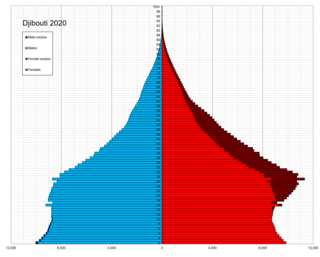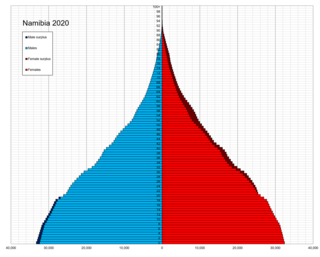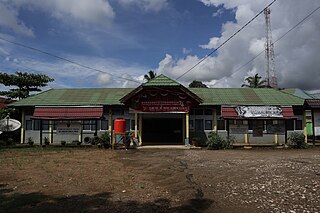
This article is about the demographic features of the population of Burundi, including population density, ethnicity, education level, health of the populace, economic status, religious affiliations and other aspects of the population.

Statistics Canada conducts a country-wide census that collects demographic data every five years on the first and sixth year of each decade. The 2021 Canadian Census enumerated a total population of 36,991,981, an increase of around 5.2 percent over the 2016 figure. Between 2011 and May 2016, Canada's population grew by 1.7 million people, with immigrants accounting for two-thirds of the increase. Between 1990 and 2008, the population increased by 5.6 million, equivalent to 20.4 percent overall growth. The main driver of population growth is immigration and, to a lesser extent, natural growth.

This article is about the demographics of Djibouti, including population density, ethnicity, education level, health, economic status, religious affiliations and other aspects of the population.

India is the second most populated country in the world with a sixth of the world's population. According to official estimates, India's population stood at 1.38 billion.

The population of Indonesia was 270.20 million according to the 2020 national census, an increase from 237.64 in 2010. Approximately 55% of Indonesia's population resides on Java, which is the most populous island in the world.

The demography of Kenya is monitored by the Kenyan National Bureau of Statistics. Kenya is a multi-ethnic state in East Africa. Its total population was at 47 558,296 as of the 2019 census.

This is a demography of the population of Namibia including population density, ethnicity, education level, health of the populace, economic status, religious affiliations and other aspects of the population.

This article is about the demographic features of the population of Seychelles, including population density, ethnicity, education level, health of the populace, economic status, religious affiliations and other aspects of the population.

The Demographics of Venezuela are the condition and overview of Venezuela's peoples. Demographic topics include basic education, health, and population statistics as well as identified racial and religious affiliations.

Samarinda is the capital city of the Indonesian province of East Kalimantan on the island of Borneo. The city lies on the banks of the Mahakam River with a land area of 718 km2 (277 sq mi). Samarinda ranks first on East Kalimantan Human Development Index and it is the most populous city on the entire Borneo island, with a population of 727,500 at the 2010 Census and 827,994 at the 2020 Census.

Statistics Indonesia, is a non-departmental government institute of Indonesia that is responsible for conducting statistical surveys. Its main customer is the government, but statistical data is also available to the public. Annual surveys include national and provincial socio-economics, manufacturing establishments, population and the labour force.

Bone Regency is a regency of South Sulawesi, Indonesia. Originally the seat of the Bone state, it joined Indonesia in 1950. The regency covers an area of 4,559.00 km2 and had a population of 717,682 at the 2010 Census, 742,527 at the 2015 Intermediate Census and 801,775 at the2020 Census. Its main products are seaweed, rice, and fish. The principal town is Watampone, which comprises the three districts of Tanete Riattang Barat, Tanete Riattang and Tanete Riattang Timur within the regency.

The Indonesia 2010 census was conducted by Statistics Indonesia in May 2010.
The 2010 Zambian census was conducted in Zambia in 2010 under the approval of the Government of Zambia, which recorded demographic data from 13 million people and 3.2 million households. The 2010 Census of Population and Housing was conducted between 16 October and 15 November 2010, with all parts of the country covered by 30 November 2010. It was the fifth national population census exercise of Zambia since its independence in 1964, with the previous censuses conducted in 1969, 1980, 1990 and 2000. A total of 3.2 million questionnaires were used for data collection and the processing started in April 2011 by the Central Statistical Office. Optical Mark Reading (OMR) and Intelligent Character Recognition (ICR) technology were used for data capture. The census was funded by United Nations Population Fund (UNFPA), the United Kingdom AID, the United States Agency for International Development (USAID) and the African Development Bank (AfDB), who contributed close to 60 per cent of the total expenditure and rest contributed by the Ministry of Finance of the Government of Zambia.

Sungai Durian, or "Durian River", is a district of Kotabaru Regency in the province of South Kalimantan, Indonesia. The population is entirely rural.

Banua Lawas is a district in Tabalong Regency, South Kalimantan Province, Indonesia. The majority of population in this district is Banjar people whose belief is Islam.
Censuses in Indonesia are censuses of Indonesia's population, agricultural, and economic data conducted by Statistics Indonesia. The first census after independence was held in 1961.














